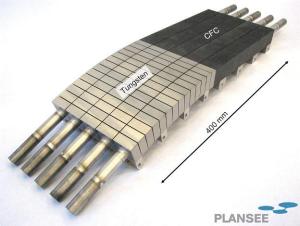Divertor test: Above most optimistic expectations
The European Domestic Agency (DA) has just delivered five "high heat flux units" within the Divertor Qualification program. The release of these parts represents a major milestone in the overall divertor qualification phase, since this means that the most demanding parts of the so-called Qualification Prototypes have been successfully manufactured.
Equally important is the fact that this has been achieved well ahead of schedule.
"In particular, I was impressed by the extremely good quality of all the units, which are practically defect-free, and, therefore, well above the quality requirements specified by ITER", declared Mario Merola, Divertor Section Leader in the ITER Organization. "Such a full-success goes above my most optimistic expectations and it is the consequence of the dedicated effort of the EU DA and, specifically, of Plansee company, in carrying out this important step towards the divertor procurement."
As stated in the Final Report of Negotiations of the ITER Joint Implementation, a qualification "...will be needed for the critical procurement packages shared by multi-Parties...", including the divertor plasma-facing components. This means that each Party allocated one of these critical procurement packages must first qualify by demonstrating its technical capability to carry out the procurement with the required quality, and in an efficient and timely manner. This is achieved via the successful manufacturing and testing of medium-size "Qualification Prototypes" (QPs). In the case of the Divertor this work is the subject of the Divertor Qualification Task Agreements.
After manufacturing is completed, the QPs, which include all the most technically challenging features of the corresponding ITER divertor design, will be subject to performance tests in the Tsefey Facility at the Efremov Institute (RF) to assess their heat flux load carrying capability. The Russian and Japanese DAs are also involved in this qualification program, which is due to be completed by the end of 2008, thus allowing the start of the divertor procurement in 2009.


